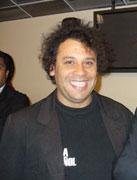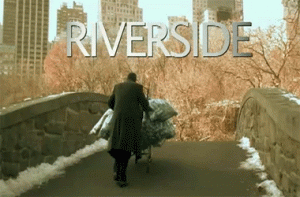Havana Film Festival to Screen Riverside

HAVANA TIMES, Nov. 28.- The life of Latin American immigrants in the United States, a theme dealt with on the movie screen from very different angles -from the most racist and stereotyped to the most violent and dramatic- has its space in the 30th Havana Film Festival (December 2-12).
Each year the festival has a “Latinos in the USA” section and among the recently made films to be screened this year is the 2007 production “Riverside”, set in New York and directed by Colombian Harold Trompetero. The others are Paraiso Travel by Simon Brand Voloj, Emilio by Kim Jorgensen and Sleep Dealer by Alex Rivera.
 Riverside is a dramatic comedy that tells the story of Hernando Martinez a 55-year-old Colombian and his wife Marina who live in New York. The couple loses everything they own and are forced to live on the street as vagabonds alongside the river, among cardboard boxes, supermarket carts, old blankets, fleas and cans. It’s then that a very peculiar idea comes to mind: try to return to their country, something that while paradoxical is the dream of many immigrants.
Riverside is a dramatic comedy that tells the story of Hernando Martinez a 55-year-old Colombian and his wife Marina who live in New York. The couple loses everything they own and are forced to live on the street as vagabonds alongside the river, among cardboard boxes, supermarket carts, old blankets, fleas and cans. It’s then that a very peculiar idea comes to mind: try to return to their country, something that while paradoxical is the dream of many immigrants.
The film is the fourth full-length movie by Trompetero, a professional advertising executive who worked for six years in New York as the creative director of the True North Communication’s Siboney USA, a multi-national ad firm. Riverside is the fruit of his experience as a Latino in the Big Apple.
Now back in his country, Trompetero has become one of today’s most renowned Colombian filmmakers. A versatile creator, he has successfully directed TV series, video clips and short films.
The screening of Riverside promises to be quite an event in Cuba, a country where emigration to the United States is something that touches hundreds of thousands of families.
Regrettably unable to travel to Cuba for the showing, Trompetero agreed to be interviewed by Havana Times and discuss his personal relationship with Cuba and his expectations for the Havana Film Festival.
HAVANA TIMES: The International Film School located on the outskirts of Havana has trained a large number of young filmmakers from all over the continent and you had the opportunity to take some courses there. How did you learn about the school and how did you get there?
HAROLD TROMPETERO: I arrived at the San Antonio de los Baños International Film School under an agreement between the school and the Javeriana University where I studied communications in Colombia. The university sent me, and it was an experience that changed my life for ever.
HT: What type of course was it?
I did a multi-faceted course in cinema. It’s the basic course that all the regular students take to decide which specialty they are going to do. The course includes practical experience in all areas of filmmaking and at the end you have to make a 16mm black and white film. The one I made was called “Lagaña” and it was shown in many festivals.
HT: When was it that you came to study in Cuba?
It was at the end of 1994 until 1996, in the middle of the “Special Period” when the economic situation was very difficult and there were shortages of everything.
HT: Could you describe a little of your experience in Cuba and what it contributed to your career?
It was marvelous. I learned that ideas and spirit were more important than the resources and the form. Besides the recollection of the film school, I have a memory of Cuba engraved in me as a place where time is stationary.
HT: In a previous interview you said that when you are shooting your films it’s as if you were in a big advertisement. “What message did Harold Trompetero want to “sell” when he made this film about Colombian immigrants in a park in New York?
Riverside was a survival scream for me. Literally if I hadn’t done it I was going to go nuts. I lived six years in New York as an immigrant and that condition was eating away at me. Although I lived like a Yuppie, with an apartment and making thousands of dollars a month, I couldn’t take what I saw and experienced around that city. The story of Riverside is for all those that dream with emigrating or those that have already done so. On the other hand, it’s a reflection about the economic systems that are collapsing in the world.
HT: The story of this Colombian couple in a New York park could be the story of any Latino immigrants in the United States, be it Mexicans, Dominicans, or even a Cubans? What’s life like for an immigrant in New York?
All immigrants face the same problems there. I think the film which best describes that is Scarface. Riverside is the flip side of the same problem. In this case, it’s not centered on the poor that want to make a fortune; instead it focuses on the rich that lose everything after having built it, like Scarface.
HT: Do you see filmmaking and advertising as conflicting? Which of the two do you prefer to express yourself and why?
There’s nothing more dangerous for the soul than pleasing environments. Obviously I prefer more challenging ways of expression.
HT: How did Riverside make it to the Havana Film Festival?
 It has just been shown at festivals in Shanghai, Oaxaca and Bogota. I regret it’s not in the official competition of the Havana Festival, but I’m proud to know that Cubans are going to see a story so close to home, since emigration is a big issue in Cuba as well.
It has just been shown at festivals in Shanghai, Oaxaca and Bogota. I regret it’s not in the official competition of the Havana Festival, but I’m proud to know that Cubans are going to see a story so close to home, since emigration is a big issue in Cuba as well.
HT: Do you have any special interest in having the film shown in Cuba?
Unfortunately, I can’t go to Cuba for the Festival, it’s a shame; it is possibly the showing I was looking forward to the most. I would love for every Cuban to see the film. When they see the end they will know why. I think it will cause a type of revolution there.
